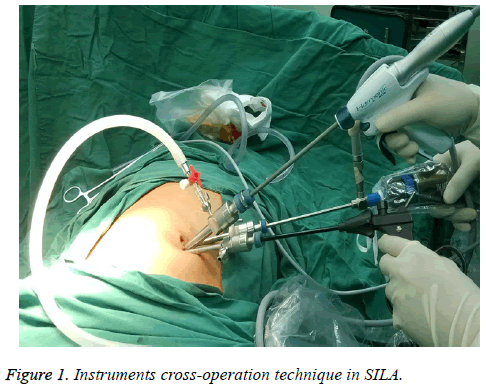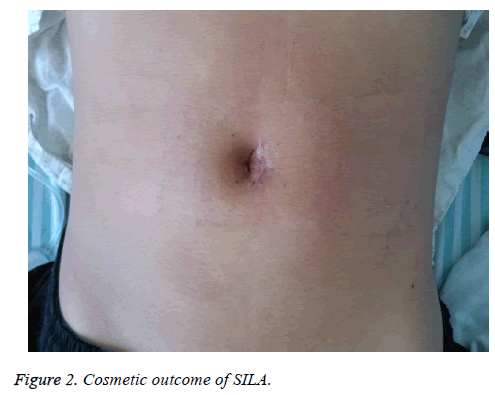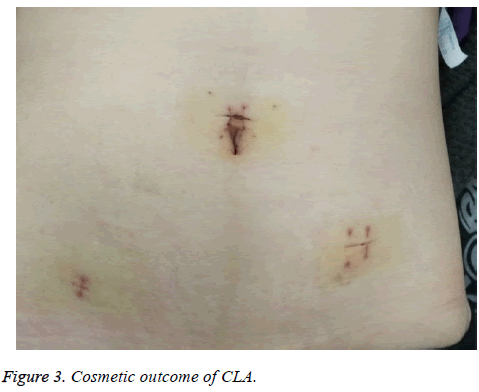Research Article - Biomedical Research (2017) Volume 28, Issue 19
Single incision laparoscopic appendectomy using conventional instruments for uncomplicated appendicitis patients
Jianxin Chen*, Shaoxiong Huang, Changyue Zheng and Wei Lin
Department of Gastrointestinal Surgery, Affiliated Hospital of Putian University, PR China
- *Corresponding Author:
- Jianxin Chen
Department of Gastrointestinal Surgery
Affiliated Hospital of Putian University, PR China
Accepted on September 14, 2017
Abstract
Background: Conventional Laparoscopic Appendectomy (CLA) is a minimum invasive operation for appendicitis patients. Single Incision Laparoscopic Appendectomy (SILA) is an operation with increasing interest to the surgeons because of the better cosmetic outcome. Using conventional instruments rather than special instruments to operate SILA can reduce treatment cost. SILA is more difficult than CLA to be performed due to the loss of triangulation and poor vision. Up to now few studies have been reported on how to overcome the operation difficulty of SILA.
Patients and Methods: A total of 107 patients with appendicitis from February 2013 to January 2015 were enrolled in this study. All patients were randomly assigned to two groups: SILA and CLA. The characteristics and perioperative outcomes were analysed.
Results: There were no significant differences in BMI, age, gender, leukocyte count, Visual Analogue Score, operation time, hospital stay, or treatment cost between two groups. Three cases of SILA group required additional troca placement to complete the operation. None of the cases required conversion to an open appendectomy.
Conclusions: SILA is a feasible and safe alternative to CLA for uncomplicated appendicitis patients. The operative difficulty can be reduced by usage of cross-operation technique.
Keywords
Appendicitis, Appendectomy, Minimally invasive surgery.
Introduction
At present, the surgery has evolved towards using less invasive techniques. Conventional Laparoscopic Appendectomy (CLA) is a minimum invasive operation for appendicitis patients. Single Incision Laparoscopic Appendectomy (SILA) is an operation with increasing interest to the surgeons because SILA has been associated with improved cosmetic benefits and decreased postoperative pain [1,2]. Using conventional instruments rather than special instruments to operate SILA can reduce treatment cost. SILA is more difficult than CLA to be performed due to the loss of triangulation and poor vision. It has been performed less in inferior hospital due to more expensive instruments and higher operative difficulty. Up to now few studies have been reported on how to overcome the operation difficulty of SILA. In this study, we performed SILA by using conventional instruments to reduce the cost, and using cross-operation technique to reduce operative difficulty.
Patients and Methods
Patients
A prospective randomized controlled trial was conducted for acute appendicitis patients in the Affiliated Hospital of Putian University from February 2013 to January 2015. The excluded criteria were as follows: (1) the course of disease was more than 48 hours; (2) the BMI of patient was more than 30 Kg/m2; (3) patients who also suffered severe diabetes; (4) those who had a story of previous abdominal operation; (5) pregnant patients; (6) those who disagreed with random selection of operation styles. A total of 107 acute appendicitis patients were recruited and randomly assigned into two groups: SILA and CLA. Informed consent was obtained from each of the patients before operation and the study was approved by Ethics Committee of Putian University. All operations were performed by the same surgeon and assistant who had finished more than 50 CLA and 20 SILA.
Surgical technique
Every patient was operated under general anesthesia. Morphine dose received was similar in both groups. All operations were performed using the same laparoscopic system (Stroz, Germany).
SILA
An incision about 5 mm was made at 1’o clock position of umbilical ring. Pneumoperitoneum was created with an intraabdominal pressure of 13 mmHg by a vertical needle, and a 5 mm troca was inserted into abdominal cavity. Abdominal cavity was examined by a 5-mm 30 degree laparoscope. Converting to CLA or open procedure is required in case of serious abdominal adhesion or difficult operating case. After assessment, the wound was extended to about 25 mm from 1- o’clock to 6-o’ clock of umbilical ring, another 5 mm troca was inserted into abdominal cavity at 6-o’ clock position of umbilical ring, and a 10-mm troca was inserted into abdominal cavity at 4-o’ clock. A surgical aspirator was inserted to extract hydrops and expose appendix. An appendix catch plier was used to lift appendix and an ultrasonic scalpel was used to dissect mesoappendix. Both the catch plier and ultrasonic scalpel intersect each other at vertical plane to reduce interference (Figure 1). The appendix was ligated at the base with two hemolocks before cutting off. To avoid touching wound directly, the appendix specimen was extracted from 10 mm troca, or a specimen bag was used when appendix was large. The umbilical wound was closed in layers.
CLA
An incision about 10 mm was made above the umbilical ring. Pneumoperitoneum was created with an intra-abdominal pressure of 13 mmHg by a vertical needle. After inserting a 10 mm troca, the peritoneal cavity was examined by using a 30 degree laparoscope. Two incisions about 5 mm were made at left lower belly and right lower belly, and two 5 mm trocas inserted respectively. The details of the appendectomy were similar to those of SILA.
Postoperative care
All patients received the same perioperative antibiotics. After surgery, each patient accepted six hours of oxygen inhalation. Liquid diet was started six hours later, and semi-liquid diet usually was given next day.
Statistical analysis
The characteristics and outcomes data of all patients were collected. The data were analysed by using SPSS version 17.0 (SPSS Inc. Chicago, USA). Continuous variables were compared using student t-test, while discrete variables were analysed with the chi-square test. P<0.05 was considered statistically significant.
Results
In this trial, 53 patients underwent SILA (group 1) while 54 patients underwent CLA (group 2). The patients’ characteristics were shown in Table 1. We found no significant differences in BMI, mean age, the gender, leukocyte count (× 109/L), Visual Analogue Score (VAS), operation time, hospital stay, or treatment cost. No serious complications were found (Table 2). Three cases of SILA group required additional troca placement to complete the operation. None of the cases required conversion to an open appendectomy. Better aesthetic outcome could be obtained for hidden single incision in the umbilicus ring in SILA group (Figure 2), compared to CLA (Figure 3).
| SILA (n=53) | CLA (n=54) | P value | |
|---|---|---|---|
| Age (y) | 37.72 ± 13.694 | 37.89 ± 14.263 | 0.949 |
| Gender (male: female) | 30:23 | 31:23 | 0.933 |
| BMI (kg/m2) | 22.238 ± 2.0498 | 22.281 ± 2.0182 | 0.912 |
| Pathologic diagnosis | |||
| Acute perforated appendicitis (n) | 2 | 3 | |
| Acute single appendicitis (n) | 7 | 11 | |
| Acute suppurative appendicitis (n) | 44 | 40 | |
| Leukocyte count (× 109/L) | 14.338 ± 2.3689 | 13.587 ± 2.1386 | 0.088 |
Table 1. The characteristics of patients.
| SILA(n=53) | CLA (n=54) | P value | |
|---|---|---|---|
| Operation time (min) | 58.23 ± 7.883 | 47.61 ± 9.438 | 0.123 |
| Conversion (n) | 0 | 0 | |
| Additional troca (n) | 3 | 0 | 0.235 |
| VAS | 3.04 ± 0.587 | 3.2 ± 0.655 | 0.17 |
| Hospital stay (d) | 3.47 ± 0.504 | 3.39 ± 0.492 | 0.392 |
| Treatment cost (RMB) | 9019.6 ± 526.527 | 8921.59 ± 445.494 | 0.301 |
| Postoperative complication | |||
| Wound infection (n) | 4 | 3 | 0.98 |
| Access site hernia (n) | 0 | 0 | |
| Ileus (n) | 0 | 0 | |
| Intra-abdominal obscess (n) | 0 | 0 | |
| Intestinal fistula (n) | 0 | 0 |
Table 2. Perioperative outcomes.
Discussion
Laparoscopic appendectomy has been widely performed in most hospitals. The advantages of laparoscopic appendectomy compared with open appendectomy are minimally invasive trauma, less postoperative pain, and better cosmesis [3,4]. SILA is a new minimally invasive operation that uses a single incision to minimize all ports to one site, and this incision can be strategically placed in the umbilicus for a hidden scarless abdomen wall [5]. Since the first report of SILA in 1992 [6], more surgeons attempt to perform this cosmetic procedure. However, it is more difficult to perform SILA than CLA, because all instruments are inserted through the same incision, leading to insufficient triangulation of traction [7-10]. To reduce the difficulty, most surgeons perform SILA by using a special multichannel single-port device, usually this device is more expensive. In order to reduce treatment cost, a few doctors perform SILA using conventional instruments, but it is more difficult. Here we describe our own simplified technique for single incision transumbilical laparoscopic appendectomy. The advantages of our method are as follows: first, using crossoperation technique at vertical plane can relieve operative interference and improve vision in surgical site; second, we do the incision beside the umbilicus, which can avoid gas leakage because of thicker abdominal wall at this site than at umbilical center.
No serious complications occurred after operation in all patients within one to three years of follow-up. Our results showed that both SILA and CLA could be successfully performed by trained surgeons. The two procedures did not differ in terms of postoperative pain, the length of hospital stay, and postoperative complications in agreement with the conclusions of previous studies [11-13]. At the beginning of our SILA procedure, we evaluated the disease by examining abdominal cavity using a 5 mm 30 degree laparoscope, and converted to open procedure or CLA procedure in case of complicated appendicitis. In our trial, three cases of SILA group required additional troca placement to complete the operation because of the serious abdominal adhesion, such adhesion may due to previous intra-abdominal infection.
In conclusion, SILA using conventional instruments is technically feasible and safe in uncomplicated appendicitis case, and achieves better aesthetic outcome in the umbilicus ring compared to CLA. Because of using the same instruments, the cost of SILA is no more than that of CLA. Therefore, SILA is an alternative procedure. However, our study has several limitations such as small sample size and single center location. Future multi-center trials with larger numbers of patients will be necessary to confirm our conclusion.
Acknowledgement
The study was supported by Putian University Grant (No. 2015049).
Conflicts of Interest
None
References
- Nguyen NT, Zainabadi K, Mavandadi S, Paya M, Stevens CM, Root J. Trends in utilization and outcomes of laparoscopic versus open appendectomy. Am J Surg 2004; 188: 813-820.
- Champault A, Polliand C, Mendes da Costa P, Champault G. Laparoscopic appendectomies: Retrospective study of 2074 cases. Surg Laparosc Endosc Percutan Tech 2008; 18: 168-172.
- Wei HB, Huang JL, Zheng ZH, Wei B, Zheng F, Qiu WS. Laparoscopic versus open appendectomy: a prospective randomized comparison. Surg Endosc 2010; 24: 266-269.
- Wei B, Qi CL, Chen TF, Zheng ZH, Huang JL, Hu BG. Laparoscopic versus open appendectomy for acute appendicitis: a meta-analysis. Surg Endosc 2011; 25: 1199-1208.
- Perez EA, Piper H, Burkhalter LS, Fischer AC. Single incision laparoscopic surgery in children: a randomized control trial of acute appendicitis. Surg Endosc 2013; 27: 1367-1371.
- Pelosi MA, Pelosi MA. Laparoscopic appendectomy using a single umbilical puncture (minilaparoscopy). J Report Med 1992; 37: 588-594.
- Kuon Lee S, You YK, Park JH, Kim HJ, Lee KK, Kim DG. Single-port transumbilical laparoscopic cholecystectomy: a preliminary study in 37 patients with gallbladder disease. J Laparoendosc Adv Surg Tech Part A 2009; 19: 495-499.
- Hong TH, Kim HL, Lee YS, Kim JJ, Lee KH, You YK. Transumbilical single-port laparoscopic appendectomy(TUSPLA): scarless intracorpareal appendectomy. J Laparoendosc Adv Surg Tech 2009; 19: 75-78.
- Markar S, Karthikesalingam A, Di Franco F, Harris A. Systematic review and meta-analysis of single-incision versus conventional multiport appendectomy. Br J Surg 2013; 100: 1709-1718.
- Montero PN, Acker CE, Heniford BT, Stefanidis D. Single Incision Laparoscopic Surgery (SILS) is associated with poorer performance and increased surgeon workload compared with standard laparoscopy. AM Surg 2011; 77: 73-77.
- Min-Soo C, Byung Soh M, Young-Ki H, Woo-Jung L. Single-site versus conventional laparoscopic appendectomy: comparison of short-term operative outcomes. Surg Endosc 2011; 25: 36-40.
- Seung Eun L, Yoo Shin C, Beom Gyu K, Seong-Jae C, Joong-Min P, In Taik C. Single port laparoscopic appendectomy in children using glove port and conventional rigid instruments. Ann Surg Treat Res 2014; 86: 35-38.
- Park J, Kwak H, Kim SG, Lee S. Single-port laparoscopic appendectomy: comparison with conventional laparoscopic appendectomy. J Laparoendosc Adv Surg Tech 2012; 22: 142-145.


